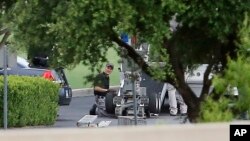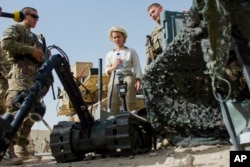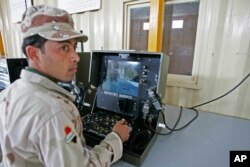Remote-controlled robots are often sent to disarm explosives. In Dallas, Texas, early Friday, one was sent to deliver a bomb.
The robot went in after negotiations broke down with a gunman suspected in a fatal ambush that killed five police officers.
"The suspect is deceased as a result of detonating the bomb," said Dallas Police Chief David Brown.
It may be the first time police have used a remote-controlled vehicle to kill a suspect.
"We saw no other option," Brown said. "Other options would have exposed our officers to grave danger."
From Baghdad to Dallas
These remote-controlled robots are typically equipped with an arm with a hand-like gripper, as well as cameras and a microphone for surveillance. The Dallas police said they placed a device on the gripper to detonate near the suspect.
The robots got their start dismantling improvised explosive devices in Iraq and Afghanistan, according to Dan Gettinger, co-director of the Bard College Center for the Study of the Drone in Annandale-on-Hudson, New York.
"Since then, a lot of these robots, as well as a lot of other military equipment, have been transferred to law enforcement agencies," he said. "It's very common for police departments large and small to have robots for explosives ordnance disposal." He added that Los Angeles has at least half a dozen.
Companies now market their robots for military and police uses, he said.
As the technology moves from military to law enforcement, Gettinger said, "I think this adoption is something that does require scrutiny on the part of the public to understand how these robots are being used."
Robot improv
Police have improvised uses for the vehicles. One in San Jose, California, delivered pizza and a cellphone to a man threatening suicide. In Albequerque, a police robot "deploy(ed) chemical munitions" in a motel room where an armed suspect had barricaded himself. The suspect surrendered.
But defense expert Peter Singer at New America, a nonpartisan research organization headquartered in Washington, posted on Twitter that this was the first time a police robot had killed a suspect.
Soldiers in Iraq have improvised a lethal remote-controlled robot, Singer added.
And the military has experimented with armed robots in Iraq.
Quinetiq North America developed a robot called SWORDS, for special weapons observation reconnaissance detection system.
The idea was to send an armed robot into a building to take out a sniper, for example, "putting the danger on the robot rather than the human," Gettinger said.
But the devices didn't work out. It's not entirely clear why, but he said commanders "were just not comfortable with a robot armed with a light machine gun operating alongside human soldiers."
Self-driving transports
All of these robots are remote-controlled and none are autonomous, Gettinger noted.
The military is developing autonomous robots, but they're more like self-driving cars than Terminators.
Convoys of self-driving trucks could deliver supplies to the front lines, "which is a pretty dangerous duty to begin with for humans," he said. "It potentially saves lives."
And the Defense Advanced Research Projects Agency envisions a squadron of robots accompanying human soldiers into combat. Robots in the air and on the ground would provide reconnaissance. Supply robots would carry gear.
"The idea is that all these robots would act in tandem with the squad," Gettinger said, "and you can't have a human operator for all these robots."
But none would be capable of delivering lethal force, he added.












